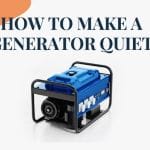As an affiliate, we may receive commissions from purchases made via our links at no additional cost to you.
Today we will discuss the quiet generator muffler silencer. Generators are an immense amount nowadays, and it’s become necessary for many purposes. It can be used in homes, schools, colleges, industries, etc. The main issue with the generator is their noise which causes many problems which can be annoying and harm our health.
That’s why it’s necessary to use the quiet generator in various ways. Among them, the most common way is by adding a muffler silencer to a generator. Here we know about all the conditions and possibilities to quiet a generator.
Quiet RV Generator : The quiet RV generator for camping or RV is preferred for large units. However, generators that produce more than 80 dB of noise are considered loud. Generators with less than 60 dB of noise are considered quiet generators.
How To Quiet Generator Muffler Silencer?
Basic steps:
- Purchase a generator that fits your needs.
- Fix the exhaust pipes up or away from you.
- Move your generator further away.
- Use sound deflectors to quiet your generator.
- Build an acoustic enclosure.
- Replace your generator’s Muffler.
- Use water as a generator muffler.
- Why Are Generators So Noisy?
Portable generators create electrical energy through an engine that can make a lot of noise, even inexpensive models. As we know, sound level is measured in decibels, which usually range between 60 and 90 but can even cross over the 100 dB level.
Gasoline- generators:
Many gasoline-powered generators are loud and sound more like a lawnmower than a car. I think probably because most consumers didn’t demand that they be quiet or marketing teams assumed that consumers thought nose power, or maybe manufacturers
I just never considered it a problem.
The technology behind the construction of generators:
As technology is improving day by day, which is making the lives of humans easy. Generators are handy in the lives of many people.
Construction:
Generators can each have AC and DC power. Alternators typically are made for alternating. Current applications, hence the name alternator.
Parts of generators.
- Frame shields electrical and moving parts.
- Fuel
- Voltage regulator
- Battery charger
- Rotor
- Stator
How Does a Generator Work?
In a turbine generator, a moving fluid, water, steam combustion gasses or air pushes a series of Blade mounted on a rotor shaft. The force of the fluid on the blades spins the rotor shaft of the Generator. The generator, in turn, converts the mechanical energy of the rotor to electrical power.
Basic technology:
Electromagnetic induction is the phenomenon used for the electric generator. They are used as standby power sources in homes, shops, offices, etc.
Why Should You Silence Your Generators?
As we know that generators are loud and heavy. But a power outage shouldn’t come with a nasty headache every time you switch the generator on. You can opt for a much more silent and eco-friendly generator for your residence.
Quiet generators are ideal for silent zones like hospitals, schools, colleges, libraries etc. The primary purpose of the silent generator is to keep the environment safe, as it is possible to produce much power with a quiet operation.
Why Are Inverter Generators So Quiet?
One of the most significant benefits of an inverter generator is how quiet it runs. Because of the compact design, inverters use a smaller engine, reducing noise levels. Another noise reduction feature is the ability to run at varying output levels. The engine design for the inverter generator is quieter than conventional generators.
How To Install a Quiet Muffler On a Generator?
Installing a quiet Muffler on your generator is a great way to reduce those loud and annoying. Sound and exhaust noises. Some quiet Mufflers are designed to fit a variety of small engines, while other manufacturers produce quiet Mufflers for specific models.
It’s essential to determine if Your equipment’s model is compatible with the quiet Muffler before attempting to install one.
Basic overview on how to install a quiet muffler.
- Assemble the Muffler parts, including the diffuser discs and resonators.
- Remove the standard Muffler on your equipment.
- Install the quiet Muffler. Use the adapter to fit the new Muffler into the exhaust port.
Once everything is installed, turn on your equipment to see if there are any exhaust leaks. Your gear should now be quieter than ever.
Can We Put Extra Mufflers on Our Generators?
We can put an automotive silencer muffler on our generators to muffle the noise. Doing this
alone can make a difference from 12 to 18 decibels. Please ensure you have good knowledge for installing them, or you might block the exhaust flow.
How Long Can You Run a Generator Continuously?
A standby generator can run for up to 3,000 hours, powering a medium-sized home. However, it is recommended you do not run a generator for longer than 500 hours continuously.
Your new generator needs to be broken like any other new or refurbished engine. Failing in a generator properly prolongs the life of the machine and other components, as they can be affected by outputs from a properly broken engine.
Instructions for a portable generator warn you not to run it in the rain. The Consumer Product Safety Commission recommends operating it on a dry surface under an open, canopy-like structure to protect it from moisture and overusing extension cords.
Generators may build up only a marginal amount of excess heat over a 12-24-hour period. Still, once you go beyond a day of continuous use, you risk building up engine heat that could permanently damage your generator.
How Do You Quiet a Generator Muffler Step by step?
Top Pick
💪 Champion Power Equipment 200986 4500-Watt Portable Inverter Generator 🏋️
✔️ QUIET TECHNOLOGY
✔️ PARALLEL READY
✔️ INTELLIGAUGE:
✔️ CLEAN POWER:
✔️ CHAMPION SUPPORT
Let’s know about each thoroughly:
01. Place on a soft surface.
Another essential factor to consider when figuring out how to quiet a generator is the surface you leave on while it’s running. Once you’ve found a reasonable distance to place your generator, you need to put it on a surface that will dampen the noise instead of amplifying it.
You should avoid all hard surfaces. So don’t place the generator on concrete, wood, or asphalt, as these surfaces will only increase the noise. Usually, dirt or grass is the best and only option to set your generator on if you’re camping. These are both great solutions as a surface to place your generator on. Both will absorb and dampen the sound created by the rumbling generator.
Say you’re in a situation where you don’t have softer ground to place your generator on. Anti-vibration mats are a great solution here. Anti-vibration mats are generally rubber and help soften the vibration and noise from household appliances. You can place one of these mats underneath your generator, which will help quiet the noise caused by the vibrations.
02. Fix the exhaust pipes vertically.
The first thing to keep in mind when you use your generator while camping is the position of the generator itself. In particular, the exhaust end of the generator.
It would help if you always placed this side of the generator away from your campsite. With some model generators, it’s also possible to point the exhaust pipes upward toward the sky. Either of these positions will direct the noise from the exhaust away from you.
03. Place it on rubber feet.
No, you aren’t looking to move. But moving the generator farther away might be a good idea. This won’t be easy if you live in an urban neighborhood where your houses are about 3 feet apart. Another factor to consider is local building codes that may dictate where you can place your generator. And those codes may supersede anything your manual suggests you do, so be sure to check.
04. Build a soundproof enclosure.
Seal edges with foil tape or acoustic caulk to make the seams airtight. A sound noise barrier will reduce the noise coming from your generator by 15-20 decibels. You can increase the noise reduction by another 5-7 decibels by adding sound absorption, like Mega Zorbe, inside the generator box.
05. Build or buy a soundproof baffle box.
It is easy to build your DIY baffle or generator sound box. You want to enclose the generator with a DIY sound box to lessen noise. Also, the trick is making sure that your generator does not overheat, and at the same time, you have easy access to the power cord while in use.
06. Use a rubber flap Cover.
Generac 51721 RUBBER, RECEPTACLE DOOR RUBBER FLAP – Manufacturer Supplied OEM Part – Special Order – Usually Ships in 3-5 Business Days.
07. Lubricates the bearing.
A generator is usually equipped with either sleeve or ball bearings mounted in end shields attached to the generator frame. Sleeve bearings are generally bronze and are lubricated with oil. Most units with sleeve-type bearings have a reservoir for the oil and a sight gauge to verify the oil level.
Once you’ve covered all your bases legally, and assuming you are using a portable generator, place it as far away from your house as an extension cord will allow.
Remember that you will never be able to make your generator permanently silent, but you can certainly do things to reduce the noise by ten or 20db. Place Your Generator On A Sound Absorbing Mat.
- Make A DIY Soundproof Box.
- Buy A Generator Box.
- Attach A New Muffler.
- Place Your Exhaust Under Water.
- Point Your Exhaust Up In The Air.
Quiet Generator Muffler Silencer (FAQ)
Can I Extend The Exhaust On Our Generators?
Yes, depending on your generator’s location, you may need to install a generator exhaust extension. Also, You can use a generator exhaust extension kit or purchase the parts individually. Also, this application will remove the exhaust to a well-ventilated area for safety.
How Hot Does a Generator exhaust Do?
Generator exhaust noise reduction systems emit temperatures anywhere from 500°F up to 1300°F depending on the unit size, manufacturer, and type of fuel burned.
Muffler Ideas To Quiet Generators.
A transportable generator noise may be an excellent method to keep you and your circle of relatives secure and snug throughout a blackout or electricity outage. Also, they may be a superb manner to keep your home equipment and electronics powered up all day or night.
However, they may be pretty noisy Generator, which may be trouble in rural neighborhoods or while getting used to a campsite. Luckily there are methods to keep it quiet.
Making a loud generator quieter is extra handy than maximum human beings think. There are many specific options, from mufflers you should purchase to DIY answers you could make at home. Each can offer a noise suppression to make the use of any generator a good deal extra bearable.
Today, we will look at a few generator muffler you can purchase and a few ways to make your generator quieter.
How Loud Is a Normal Generator?
The decibel levels of familiar sound waves above 80 dB are considered ‘loud.’ In comparison, the decibel levels between 100-125 dB are termed ‘uncomfortable.’ So, all the machines operating in an area should produce noise within the acceptable noise level to maintain the well-being of the people around. Westinghouse iGen1200 Super Quiet Portable Inverter :
The Westinghouse 1,000-watt iGen1200 is a fine example of a low-cost portable inverter generator for those with modest demands.
In addition to its minimal weight, a 52 decibel sound waves level makes this portable model among the quietest generators in its class.
How To Make Generators Quiet For Camping?
Install rubber anti-vibration pads. Check the muffler/install a secondary Muffler.
- Change the position of the exhaust pipe.
- Use water as a sound dampener.
- Change the location of your generator.
- Make a generator quiet box (aka baffle box aka generator muffler box)
Can You Put a Baffle On a Generator?
It is straightforward to build your DIY baffle box or generator sound box. You want to enclose the generator with a DIY sound box to lessen noise. Also, the trick is ensuring that your generator does not overheat and, simultaneously, you have easy access to the power cord while in use.
Final Thoughts on Quiet Generator Muffler Silencer :
I hope these tips will help you decide how to make your generator as quiet as a cricket. Some are more practical than others, but it ultimately depends on the type of generator and your willingness to get building.
Using a quiet Generator Muffler
Quieter Generators may be a brilliant asset in a home or business. However, like any matter in the world, they could have drawbacks if now no longer established efficiently. One of those shortcomings is an exhaust device that creates an ugly and obnoxious noise. When you put in your device, you ought to take the time to install your exhaust correctly so that you do not scare yourself while you pay attention to it.
Cautions :
You should in no way run your generator or another internal combustion engine inside the building where humans or animals live. Also, you should no longer input into the construction or enclosure having one. Doing so may also cause loss of life because of dangerous exhaust fumes. Placing your generator close to flammable materials will threaten a fire accident.












